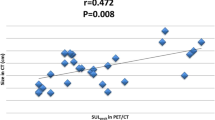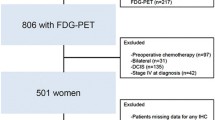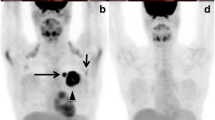Abstract
Fluorine-18 fluorodeoxyglucose positron emission tomography (FDG-PET) has been used successfully for the staging and re-staging of breast cancer. Another significant indication is the evaluation of therapy response. Only limited data are available on the use of FDG-PET in breast cancer after radiation therapy. The same holds true for chemotherapy. Only the therapy response in locally advanced breast cancer after chemotherapy has been investigated thoroughly. Histopathological response could be predicted with an accuracy of 88–91% after the first and second courses of therapy. A quantitative evaluation is, of course, a prerequisite when FDG-PET is used for therapy monitoring. Only a small number of studies have focussed on hormone therapy. In this context, a flare phenomenon with increasing standardised uptake values after initiation of tamoxifen therapy has been observed. More prospective multicentre trials will be needed to make FDG-PET a powerful tool in monitoring chemotherapy in breast cancer.


Similar content being viewed by others
References
Biersack HJ, Palmedo H, Bender H, Krause T. Nuclear medicine and breast cancer. In: Freeman LM, ed. Nuclear medicine annual 2001. Philadelphia: Lippincott Williams & Wilkins; 2001:69–108.
Kostakoglu L, Goldsmith SJ.18F-FDG-PET evaluation of the response to therapy for lymphoma and for breast, lung and colorectal carcinoma. J Nucl Med 2003; 44:224–239.
Grahek D, Montravers F, Kerrou K, Aide N, Lotz JP, Talbot JN. [18F]FDG in recurrent breast cancer: Diagnostic performances, clinical impact and relevance of induced changes in management. Eur J Nucl Med Mol Imaging 2004; 31:179–188.
Biersack HJ, Palmedo H. Locally advanced breast cancer: Is PET useful for monitoring primary chemotherapy? J Nucl Med 2003; 44:1815–1817.
Haberkorn U, Reinhardt M, Strauss LG. Metabolic design of combination therapy: use of enhanced fluorodeoxyglucose uptake caused by chemotherapy. J Nucl Med 1987; 33:1981–1987.
Minn H, Soini I. (18F)Fluorodeoxyglucose scintigraphy in diagnosis and follow-up of treatment in advanced breast cancer. Eur J Nucl Med Mol Imaging 1989; 15:61–66.
Lowe VJ. PET in radiotherapy. In: Oehr P, Biersack HJ, Coleman RE, eds. PET and PET-CT in oncology. Berlin Heidelberg New York: Springer; 2003:303–308.
Bockisch A, Freudenberg L, Antoch G, Müller S. PET/CT: clinical considerations. In: Oehr P, Biersack HJ, Coleman RE, eds. PET and PET-CT in oncology. Berlin Heidelberg New York: Springer; 2003:101–125.
Jones DN, McCowage GW, Soestman HD, et al. Monitoring of neoadjuvant therapy response of soft-tissue and musculoskeletal sarcoma using fluorine-18-FDG-PET. J Nucl Med 1996; 37:1438–1444.
Vranjesevic D, Filmont JE, Meta J, et al. Whole body (18F)-FDG-PET and conventional imaging for predicting outcome in previously treated breast cancer patients. J Nucl Med 2002; 43:325–329.
Jansson T, Westlin JE, Ahlstrom H, Lilja A, Langstrom B, Bergh J. Positron emission tomography studies in patients with locally advanced and/or metastatic breast cancer: a method for early therapy evaluation? J Clin Oncol 1995; 13:1470–1477.
Wahl RL, Zasadny K, Helvie M, et al. Metabolic monitoring of breast cancer chemo-hormonotherapy using positron emission tomography: Initial evaluation. J Clin Oncol 1993; 11:2101–2111.
Gennari A, Donati S, Salvadori B et al. Role of 2-(18F)-fluorodeoxyglucose (FDG) positron emission tomography (PET) in the early assessment of response to chemotherapy in metastatic breast cancer patients. Clin Breast Cancer 2000; 1:156–161.
Tiling R, Linke R, Untch M, et al.18F-FDG-PET and 99mTc-sestamibi scintimammography for monitoring breast cancer response to neoadjuvant chemotherapy: a comparative study. Eur J Nucl Med Mol Imaging 2001; 28:711–720.
Krak NC, van der Hoeven JJ, Hoekstra OS, et al. Measuriing [18F]FDG uptake in breast cancer during chemotherapy: comparison of analytical methods. Eur J Nucl Med Mol Imaging 2003; 30:674–681.
Fisher B, Brown A, Mamounas E, et al. Effect of preoperative chemotherapy on local-regional disease in women with operable breast cancer: findings from National Surgical Adjuvant Breast and Bowel Project B-18. J Clin Oncol 1997; 15:2483–2493.
Booser DJ, Hortobagyi GN. Treatment of locally advanced breast cancer. Semin Oncol 1992; 19:278–285.
Machiavelli M, Romero A, Pérez K, et al. Prognostic significance of pathological response of primary tumor and metastatic axillary lymph nodes after neoadjuvant chemotherapy for locally advanced breast carcinoma. Cancer J Sci Am 1998; 4:125–131.
Chollet P, Charrier S, Brain E, et al. Clinical and pathological response to primary chemotherapy in operable breast cancer. Eur J Cancer 1997; 3:862–866.
Vinnicombe SJ, MacVicar AD, Guy RL, et al. Primary breast cancer: mammographic changes after neoadjuvant chemotherapy, with pathologic correlation. Radiology 1996; 198:333–340.
Mankoff DA, Dunnwald LK, Gralow JR, et al. Blood flow and metabolism in locally advanced breast cancer: relationship to response to therapy. J Nucl Med 2002; 43:500–509.
Palmedo H. What can we expect from MDR breast cancer imaging with sestamibi? J Nucl Med 2002; 43:526–529.
Sagar SM, Klassen GA, Barclay KD, Aldrich JE. Antitumor treatment: tumor blood flow—measurement and manipulation for therapeutic gain. Cancer Treat Rev 1993; 19:299–349.
Wilson CBJH, Lammertsma AA, McKienzie CG, Sikora K, Johns T. Measurement of blood flow and exchanging water space in breast tumors using positron emission tomography: a rapid and non-invasive dynamic method. Cancer Res 1992; 52:1592–1597.
Mankoff DA, Dunnwald LK, Gralow JR, et al. Monitoring the response of patients with locally advanced breast carcinoma to neoadjuvant chemotherapy using (technetium-99m)-sestamibi scintimammography. Cancer 1999; 85:2410–2423.
Teicher BA. Hypoxia and drug resistance. Cancer Metastasis Rev 1994; 13:139–168.
Mankoff DA, Dunnwald LK, Gralow JR, et al. Changes in blood flow and metabolism in locally advanced breast cancer (LABC) treated with neo-adjuvant chemotherapy. J Nucl Med 2003; 44:1806–1814.
Bassa P, Kim EE, Inoue T et al. Evaluation of preoperative chemotherapy using PET with fluorine-18-fluorodeoxyglucose in breast cancer. J Nucl Med 1996; 37:931–938.
Schelling M, Avril N, Nährig J, et al. Positron emission tomography using [18F]fluorodeoxyglucose for monitoring primary chemotherapy in breast cancer. J Clin Oncol 2000; 18:1689–1695.
Smith IC, Welch AE, Hutcheon AW, et al. Positron emission tomography using [18F]-fluorodeoxy-d-glucose to predict the pathologic response of breast cancer to primary chemotherapy. J Clin Oncol 2000; 18:1676–1688.
Weber WA, Schwaiger M, Avril N. Quantitative assessment of tumor metabolism using FDG-PET imaging. Nucl Med Biol 2002; 27:683–687.
Bender H, Bangard M, Metten N, et al. Possible role of FDG-PET in the early prediction of therapy outcome in liver metastases of colorectal cancer. Hybridoma 1999; 18:87–91.
McGuire AH, Dehdashti F, Siegel BA, et al. Positron tomographic assessment of 16α-[18F]fluoro-17β-estradiol uptake in metastatic breast carcinoma. J Nucl Med 1991; 32:1526–1531.
Jonson SD, Welch MJ. PET imaging of breast cancer with fluorine-18 radiolabelled estrogens and progestins. Q J Nucl Med 1998; 42:8–17.
Inoue T, Kim EE, Wallace S, et al. Positron emission tomography using [18F}fluoro-tamoxifen to evaluate therapeutic responses in patients with breast cancer: preliminary study. Cancer Biother Radiopharm 1996; 11:235–245.
Dehdashti F, Flanagan FL, Mortimer JE, et al. Positron emission tomographic assessment of “metabolic flare” to predict response of metastatic breast cancer to antiestrogen therapy. Eur J Nucl Med 1999; 26:51–56.
Author information
Authors and Affiliations
Corresponding author
Rights and permissions
About this article
Cite this article
Biersack, HJ., Bender, H. & Palmedo, H. FDG-PET in monitoring therapy of breast cancer. Eur J Nucl Med Mol Imaging 31 (Suppl 1), S112–S117 (2004). https://doi.org/10.1007/s00259-004-1533-x
Published:
Issue Date:
DOI: https://doi.org/10.1007/s00259-004-1533-x




